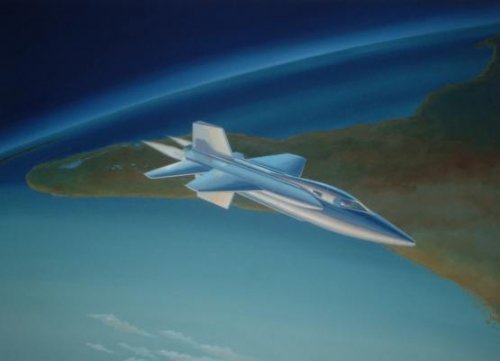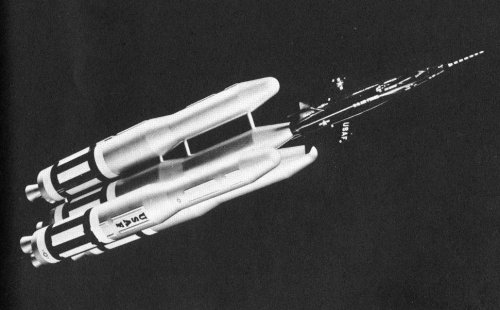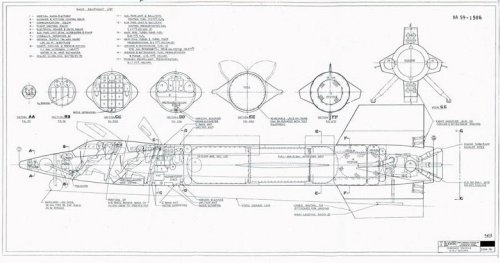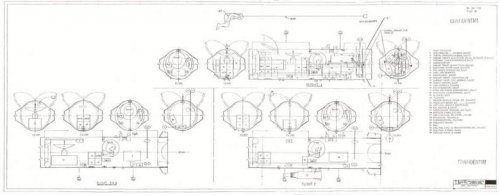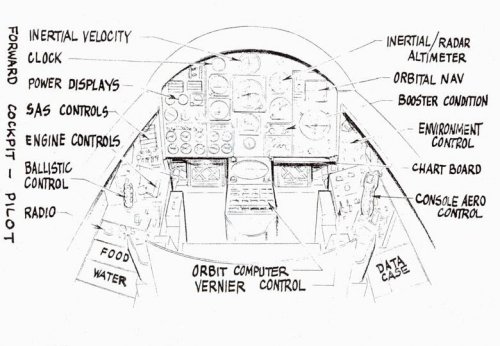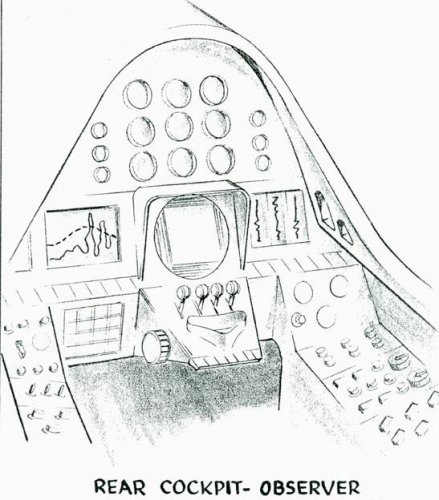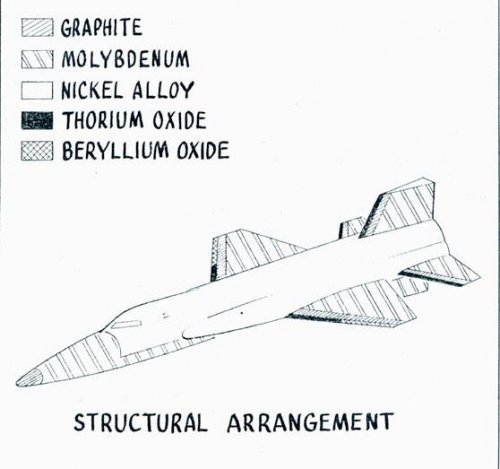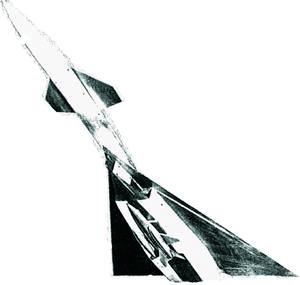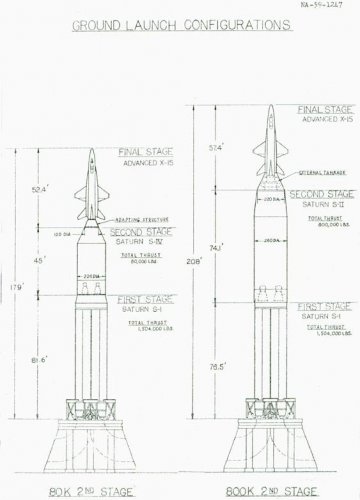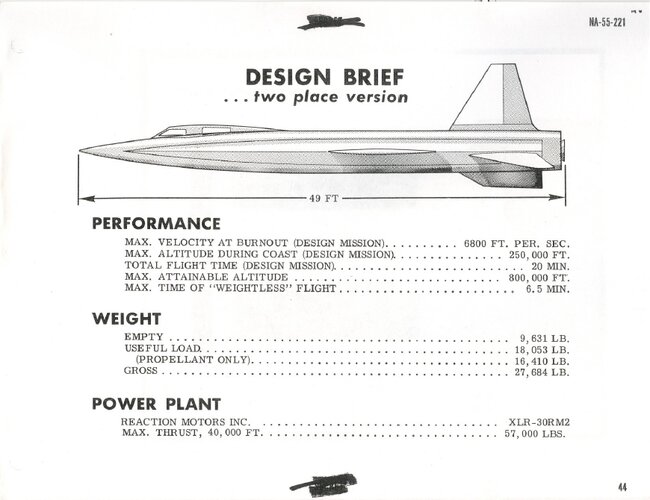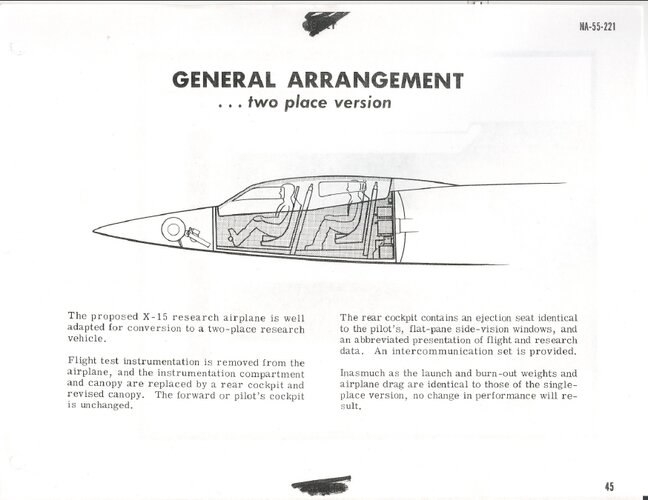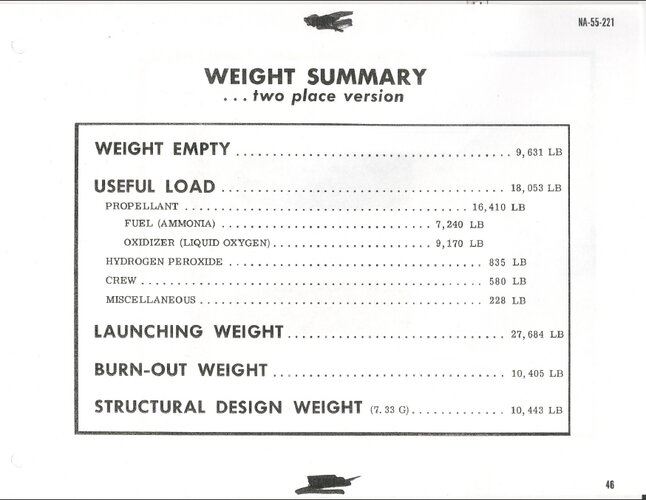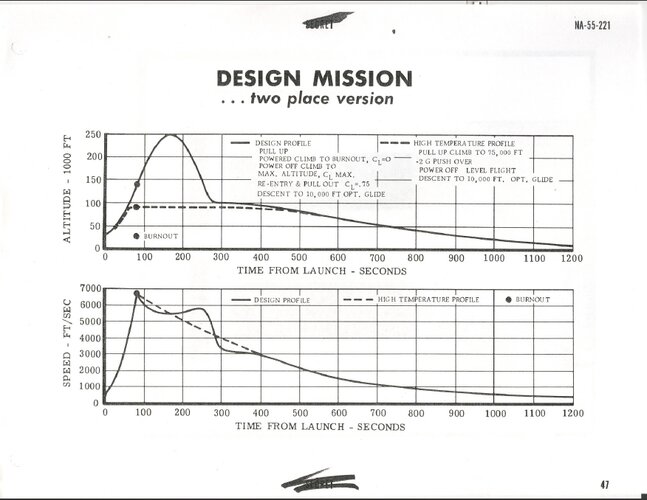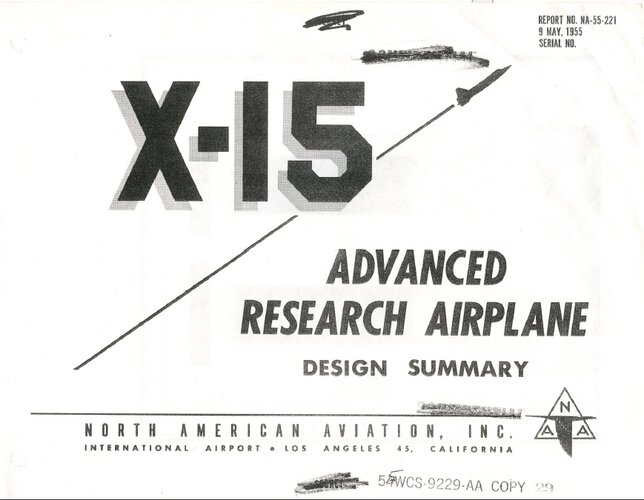You are using an out of date browser. It may not display this or other websites correctly.
You should upgrade or use an alternative browser.
You should upgrade or use an alternative browser.
X-15B - an orbital X-15
- Thread starter Orionblamblam
- Start date
It's a photo of the actual painting. A few years back I managed to get into the back room of the Boeing archives and take some pictures; this was on a pile of Rockwell art that had not yet been cataloged.
I have a little more on the design, but just a little. The drawings I am reserving until my Bomber Projects book comes out. But this was to be launched off of an antirely new and rather odd booster, which looked *somewhat* like the S-I first stage.
I have a little more on the design, but just a little. The drawings I am reserving until my Bomber Projects book comes out. But this was to be launched off of an antirely new and rather odd booster, which looked *somewhat* like the S-I first stage.
In the Spring 08 issue of Air Power History, there's an article regarding on building a X-15B for Early Orbital Manned Spaceflight. They posted a cutaway drawing for a 2 man version and drawings of it being mounted on early proposed Saturn launchers.
Dennis
Dennis
XP67_Moonbat
ACCESS: Top Secret
- Joined
- 16 January 2008
- Messages
- 2,246
- Reaction score
- 375
- Joined
- 22 January 2006
- Messages
- 3,891
- Reaction score
- 1,150
An X-15 on a trio of Titan 1's
amazing, thanks a lot!
- Joined
- 29 September 2006
- Messages
- 1,626
- Reaction score
- 1,022
XP67_Moonbat said:An X-15 on a trio of Titan 1's. I found this while looking for mystery NASA hypersonic the other day. I guess this would fall uner one of those orbital X-15 proposals.
Moonbat
Nice! However, I'm going to have to be pedantic and call that a quad of Titan 1's...
airrocket
Dreams To Reality
Moonbat
The X-15 shown is the early version. That would've been one sweet ride. However given the heat damage received after the record breaking 4,520 mph flight. I doubt the X-15 structure would have survived an orbital reentry. Pity we can't envision such vehicle combo's today.
The X-15 shown is the early version. That would've been one sweet ride. However given the heat damage received after the record breaking 4,520 mph flight. I doubt the X-15 structure would have survived an orbital reentry. Pity we can't envision such vehicle combo's today.
- Joined
- 13 August 2007
- Messages
- 7,125
- Reaction score
- 6,438
XP67_Moonbat said:An X-15 on a trio of Titan 1's. I found this while looking for mystery NASA hypersonic the other day. I guess this would fall uner one of those orbital X-15 proposals.
Moonbat
with cluster of 4 Titan-1 booster !
that is a Orbital X-15 Proposal
but this Model give me a Headaches
how hell goes the stage seperation ?
- Joined
- 1 April 2006
- Messages
- 10,719
- Reaction score
- 6,682
source
X-15B: THE SPACEPLANE THAT ALMOST WAS
by Dr. L. Parker Temple III
IAC-06-E4.3.01
57th International Astronautical Congress, Valencia, Spain, Oct. 2-6, 2006
X-15B: THE SPACEPLANE THAT ALMOST WAS
by Dr. L. Parker Temple III
IAC-06-E4.3.01
57th International Astronautical Congress, Valencia, Spain, Oct. 2-6, 2006
Attachments
- Joined
- 1 April 2006
- Messages
- 10,719
- Reaction score
- 6,682
Various launch methods offered.
sources
SATURN/X-15 Flight Research Program Report
X-15B: THE SPACEPLANE THAT ALMOST WAS
by Dr. L. Parker Temple III
IAC-06-E4.3.01
57th International Astronautical Congress, Valencia, Spain, Oct. 2-6, 2006
sources
SATURN/X-15 Flight Research Program Report
X-15B: THE SPACEPLANE THAT ALMOST WAS
by Dr. L. Parker Temple III
IAC-06-E4.3.01
57th International Astronautical Congress, Valencia, Spain, Oct. 2-6, 2006
Attachments
Lauge
ACCESS: Secret
- Joined
- 30 January 2008
- Messages
- 434
- Reaction score
- 46
flateric said:Various launch methods offered.
sources
SATURN/X-15 Flight Research Program Report
X-15B: THE SPACEPLANE THAT ALMOST WAS
by Dr. L. Parker Temple III
IAC-06-E4.3.01
57th International Astronautical Congress, Valencia, Spain, Oct. 2-6, 2006
Please tell me those "legs" are just part of the launch pad, and not the shock absorbers for an Orion-style propulsion system.....
(Sorry, couldn't help myself).
Regards & all,
Thomas L. Nielsen
Denmark
Lauge said:flateric said:Various launch methods offered.
sources
SATURN/X-15 Flight Research Program Report
X-15B: THE SPACEPLANE THAT ALMOST WAS
by Dr. L. Parker Temple III
IAC-06-E4.3.01
57th International Astronautical Congress, Valencia, Spain, Oct. 2-6, 2006
Please tell me those "legs" are just part of the launch pad, and not the shock absorbers for an Orion-style propulsion system.....;D
(Sorry, couldn't help myself).
Regards & all,
Thomas L. Nielsen
Denmark
The trio of Titans and the X15; just a thought, was there UK influence with a Zero stage and all four burning and propellant transfer to the central “sustainer” first/second stage?
Or was it three and then one or all three and the X15 as a second stage to orbit?
XP67_Moonbat
ACCESS: Top Secret
- Joined
- 16 January 2008
- Messages
- 2,246
- Reaction score
- 375
It was a quad of Titans, huh? My bad. ;D
Flateric,
Thanks for posting the X-15 + XB-70 pic. The fanciful illustrations of the delta-winged X-15A-3 (sometimes called "X-15B" by mistake) launching off the back of the XB-70 are pretty common, but this pic is a much more realistic concept.
Is it pretty certain that it would be too difficult to achieve clean separation by launching the X-15 from the topside of the XB-70?
Thanks for posting the X-15 + XB-70 pic. The fanciful illustrations of the delta-winged X-15A-3 (sometimes called "X-15B" by mistake) launching off the back of the XB-70 are pretty common, but this pic is a much more realistic concept.
Is it pretty certain that it would be too difficult to achieve clean separation by launching the X-15 from the topside of the XB-70?
CFE said:Flateric,
Thanks for posting the X-15 + XB-70 pic. The fanciful illustrations of the delta-winged X-15A-3 (sometimes called "X-15B" by mistake) launching off the back of the XB-70 are pretty common, but this pic is a much more realistic concept.
Is it pretty certain that it would be too difficult to achieve clean separation by launching the X-15 from the topside of the XB-70?
Sorry XP67_Moonbat,
Yes a Quad of Titans and the X15;
Just a thought.
Was there UK influence with a “Zero stage” and all four burning and propellant transfer to the central “sustainer” first/second stage?
Or was it three and then one followed by a X15 third stage?
Or all four and the X15 as a second stage to orbit?
CFE
The X15 from the back of a XB 70 is similar to that proposed circa 1955 for the Avro 720 from the back of a Vulcan or the SR53 from the back of a Valiant.
Bet it would be easier from the XB70 or was there a real problem with the piggyback idea?
Quindar Beep
"I really hope they fix that"
I've just found the names and reference numbers to two NAA reports about the later X-15B proposals to launch it on a Saturn (a Saturn I, one presumes). I can find FOI requests for them dating to 2006-7 that seem to have been granted, but unfortunately I haven't been able to find either on the NASA Technical Reports Server, DTIC Online, or a fairly deep Google around.
Here's the names, and I hope someone's search-fu is better than *and* that someone will want to post what they find back to here!
SATURN/X-15 Flight Research Program Report, November 19,1959, NA 59-1586
SATURN/X-15 Technical Summary Report, November 19, 1959, NA 59-1247
Here's the names, and I hope someone's search-fu is better than *and* that someone will want to post what they find back to here!
SATURN/X-15 Flight Research Program Report, November 19,1959, NA 59-1586
SATURN/X-15 Technical Summary Report, November 19, 1959, NA 59-1247
Quindar Beep said:SATURN/X-15 Technical Summary Report, November 19, 1959, NA 59-1247
This is in the non-public DTIC section.
I also found another reference in a Saturn bibliography on NTRS you might want to add to the list.
SATURN/X-15 Proposal, North American Aviation Report No. NA-60-447, April 21, 1960.
The bibliography on NTRS is:
A bibliography of the saturn system
Online Source: Click to View PDF File [PDF Size: 4.4 MB]
Author: Mc Clard, T. E.
Abstract: Bibliography - saturn system NASA Center: Marshall Space Flight Center
Publication Year: 1962
Document ID: 19640004360
Accession Number: 64N14274
Report/Patent Number: NASA-TM-X-50409, M-SAT-62-4
Updated/Added to NTRS: Apr 07, 2011
- Joined
- 16 December 2010
- Messages
- 2,828
- Reaction score
- 2,050
XP67_Moonbat said:An X-15 on a trio of Titan 1's. I found this while looking for mystery NASA hypersonic the other day. I guess this would fall uner one of those orbital X-15 proposals.
Moonbat
I wonder if Gerry Anderson saw that...
But in a slightly more serious note, a blog covering various unbuilt/unsuccessful space projects called 'False Steps' did a feature article on the X-15b
http://falsesteps.wordpress.com/2012/09/15/x-15b-shortcut-to-space/
Quindar Beep
"I really hope they fix that"
Graham1973 said:But in a slightly more serious note, a blog covering various unbuilt/unsuccessful space projects called 'False Steps' did a feature article on the X-15b
http://falsesteps.wordpress.com/2012/09/15/x-15b-shortcut-to-space/
...and the Circle of Life is complete. That's my blog
I came across the two report names I mentioned about while researching the article. I never did find copies of them, but I did find an article from Air Power History(*) whose author clearly had, so I went ahead and wrote it up -- I prefer primary sources, but I'll go with it with a couple or more secondary sources reconcile and aren't obviously based on each other (as often happens).
I figure I can always go back and edit it if I find copies of the reports before the manuscript is finished up.
(*) Which reminds me, I've got to add it to my bibliography -- credit where credit is due.
http://www.thefreelibrary.com/X-15B%3A+pursuit+of+early+orbital+human+spaceflight.-a0176777619
XP67_Moonbat
ACCESS: Top Secret
- Joined
- 16 January 2008
- Messages
- 2,246
- Reaction score
- 375
Hey where'd the rest of the pics on this thread go? 
XP67_Moonbat
ACCESS: Top Secret
- Joined
- 16 January 2008
- Messages
- 2,246
- Reaction score
- 375
I say again...where'd the rest of the stuff go? 
Sure you're not thinking of this thread?
http://www.secretprojects.co.uk/forum/index.php/topic,6382.msg208910.html#msg208910
http://www.secretprojects.co.uk/forum/index.php/topic,6382.msg208910.html#msg208910
XP67_Moonbat
ACCESS: Top Secret
- Joined
- 16 January 2008
- Messages
- 2,246
- Reaction score
- 375
I stand corrected. That being said, my bad! ;D
Folks,
The below article mentions an orbital X-15 with no internal tanks but toroidal ones on the aft end, sadly no pictures…
But another article by L. Parker Temple III “X-15B - The Spaceplane That Almost Was.” Makes no mention of these but has some small illustrations which I have only recently noticed shows these! They are shown earlier in this thread.
Aviation Week January 18, 1960
Dyna-Soar Design Under Review;
New X-15 Proposed as Substitute
Washington – Complete re-evaluation of the design of Air Force’s Dyna-Soar vehicle is under way, with a ballistic configuration now being weighted against a winged glider. The review was ordered by Joseph Charyk, USAF assistant secretary for research and development, and now includes companies not previously involved in the protracted design studies.
Review, to be completed by Mar. 1, is called Phase Alpha. Assisting the Boeing Airplane Co., vehicle prime contractor, are Bell, Lockheed, General Electric, Avco, McDonnell and Chance Vought. Until now, only winged gliders have been considered. Avco, GE, McDonnell and possibly Lockheed, were believed to have been brought in to introduce the possibility of a ballistic configuration, which might be similar to the Mercury capsule.
Meanwhile, a substitute for Dyna-Soar has been proposed by North American , Inc. It would be a two-man research aircraft with the same external shape and dimensions as the X-15 but with almost entirely new materials and construction methods. It eventually would be boosted into orbit by a two-stage Saturn but initial phases are based on quick availability of hard-ware.
Wing leading edges, fuselage nose and other areas which would encounter high temperatures during re-entry would be made of a beryllium oxide of marble like appearance. This material, which would withstand temperatures up to about 4,900F., would be backed up with a coated graphite capable of withstanding temperatures of about 3,600F. Back of the leading edge, the wing structure would be made of molybdenum alloy, as would cooler portions of fuselage.
Major external innovation in the X-15 aircraft to permit orbital flight is the addition of two doughnut-shaped tanks for rocket engine fuel and oxidiser. These torus tanks will be placed on the aft end of the fuselage, and the opening in their center will be shaped so that they will form an extension to the nozzle of the Reaction Motors XLR-99 engine which is also used on the current X-15. The extension will provide a much greater nozzle expansion ratio and give the engine better performance for its task of providing the final velocity increment to place the aircraft in orbit.
All of the propellants for the main rocket engine would be carried in the external tanks, and the major portion of the internal volume of the orbital X-15 would be devoted to instrumentation. The second crewman in this proposed vehicle sits behind the pilot in what is the instrumentation bay on the current X-15.
One version of the orbital vehicle would have eight XLR-101 rocket engines mounted in the large, blunt trailing edge of the vertical tails to provide braking or retro-thrust during re-entry. Fuel for these rockets would be carried in the fuselage, and the main torus tanks would be dropped as soon as the vehicle achieved an orbit.
Nozzles on these eight retro-engines would face to the rear, and the aircraft would have to be pointed tail-first for them to provide braking thrust and initiate a re-entry maneuver. Maximum heating during such a re-entry would not occur for 10 min. or so after the retro rockets stopped firing, so the aircraft could be turned around with its attitude control jets before aerodynamic loads and heating became high.
It is also planned to carry a small amount of propellant after retro-firing so that these eight rockets could be used briefly during landing to improve the X-15’s characteristics during this flight phase, which is now considered marginal by many engineers. The XLR-101 engines proposed for retro-thrust use have been used successfully for some time as Vernier rockets in the Atlas, Thor and Jupiter missiles.
Useful payload of the orbital X-15 with retro-thrust engines would include 4,000 lb. of instrumentation in the former fuel tank area if the vehicle was sent into a 100 mi. circular orbit. If the retro-engines were discarded and only aerodynamic braking was used during the re-entry, the orbital altitude could be increased to about 200 mi. with the two ton instrument load. Maximum altitude for an elliptical orbit would go up to 1,900 mi. with zero instrumentation weight and using aerodynamic re-entry braking.
Performance figures of the orbital X-15 are subject to change if the Saturn booster undergoes further change. Present figures are based on the use of the eight engine Saturn first stage cluster now under development at Huntsville, Ala., which uses JP-4 and liquid oxygen propellants.
Regards,
Barry
The below article mentions an orbital X-15 with no internal tanks but toroidal ones on the aft end, sadly no pictures…
But another article by L. Parker Temple III “X-15B - The Spaceplane That Almost Was.” Makes no mention of these but has some small illustrations which I have only recently noticed shows these! They are shown earlier in this thread.
Aviation Week January 18, 1960
Dyna-Soar Design Under Review;
New X-15 Proposed as Substitute
Washington – Complete re-evaluation of the design of Air Force’s Dyna-Soar vehicle is under way, with a ballistic configuration now being weighted against a winged glider. The review was ordered by Joseph Charyk, USAF assistant secretary for research and development, and now includes companies not previously involved in the protracted design studies.
Review, to be completed by Mar. 1, is called Phase Alpha. Assisting the Boeing Airplane Co., vehicle prime contractor, are Bell, Lockheed, General Electric, Avco, McDonnell and Chance Vought. Until now, only winged gliders have been considered. Avco, GE, McDonnell and possibly Lockheed, were believed to have been brought in to introduce the possibility of a ballistic configuration, which might be similar to the Mercury capsule.
Meanwhile, a substitute for Dyna-Soar has been proposed by North American , Inc. It would be a two-man research aircraft with the same external shape and dimensions as the X-15 but with almost entirely new materials and construction methods. It eventually would be boosted into orbit by a two-stage Saturn but initial phases are based on quick availability of hard-ware.
Wing leading edges, fuselage nose and other areas which would encounter high temperatures during re-entry would be made of a beryllium oxide of marble like appearance. This material, which would withstand temperatures up to about 4,900F., would be backed up with a coated graphite capable of withstanding temperatures of about 3,600F. Back of the leading edge, the wing structure would be made of molybdenum alloy, as would cooler portions of fuselage.
Major external innovation in the X-15 aircraft to permit orbital flight is the addition of two doughnut-shaped tanks for rocket engine fuel and oxidiser. These torus tanks will be placed on the aft end of the fuselage, and the opening in their center will be shaped so that they will form an extension to the nozzle of the Reaction Motors XLR-99 engine which is also used on the current X-15. The extension will provide a much greater nozzle expansion ratio and give the engine better performance for its task of providing the final velocity increment to place the aircraft in orbit.
All of the propellants for the main rocket engine would be carried in the external tanks, and the major portion of the internal volume of the orbital X-15 would be devoted to instrumentation. The second crewman in this proposed vehicle sits behind the pilot in what is the instrumentation bay on the current X-15.
One version of the orbital vehicle would have eight XLR-101 rocket engines mounted in the large, blunt trailing edge of the vertical tails to provide braking or retro-thrust during re-entry. Fuel for these rockets would be carried in the fuselage, and the main torus tanks would be dropped as soon as the vehicle achieved an orbit.
Nozzles on these eight retro-engines would face to the rear, and the aircraft would have to be pointed tail-first for them to provide braking thrust and initiate a re-entry maneuver. Maximum heating during such a re-entry would not occur for 10 min. or so after the retro rockets stopped firing, so the aircraft could be turned around with its attitude control jets before aerodynamic loads and heating became high.
It is also planned to carry a small amount of propellant after retro-firing so that these eight rockets could be used briefly during landing to improve the X-15’s characteristics during this flight phase, which is now considered marginal by many engineers. The XLR-101 engines proposed for retro-thrust use have been used successfully for some time as Vernier rockets in the Atlas, Thor and Jupiter missiles.
Useful payload of the orbital X-15 with retro-thrust engines would include 4,000 lb. of instrumentation in the former fuel tank area if the vehicle was sent into a 100 mi. circular orbit. If the retro-engines were discarded and only aerodynamic braking was used during the re-entry, the orbital altitude could be increased to about 200 mi. with the two ton instrument load. Maximum altitude for an elliptical orbit would go up to 1,900 mi. with zero instrumentation weight and using aerodynamic re-entry braking.
Performance figures of the orbital X-15 are subject to change if the Saturn booster undergoes further change. Present figures are based on the use of the eight engine Saturn first stage cluster now under development at Huntsville, Ala., which uses JP-4 and liquid oxygen propellants.
Regards,
Barry
Hafidz Rahman
Just an Aeroweebs...
Similar threads
-
-
-
Candidate Space Shuttle Orbiters Wind Tunnel Studies 1969 NASA Langley Research
- Started by sferrin
- Replies: 2
-
-
"Cold War American Spacecraft Projects and the “Paperclip” connection."
- Started by Orionblamblam
- Replies: 9

